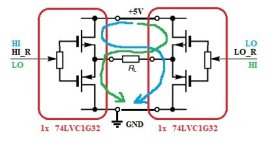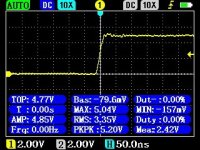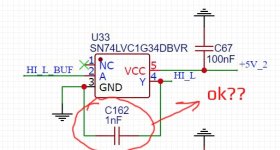I don't have free time right now for ddpd mini but soon I will back to it and try to measure things inside bridge in relation to bufer stage which seems cause problem with resolution lost because of to many half bridges connected in paralel to just one bufer, in our case 1 buffer is driving 16 half bridges which seems is a bad idea. I will do some measurements by osciloscope when I get some free time. I have other projects using the almost the same principle, DSC2 dac and analog things, getting 17.9bits of resolution and a fact that there is too many digital to analog analog to digital stages from-to input to the speakers, this ddpd must be definitelly a lot better in resolution since a lot less DA AD conversions in comparation to my other projects, it must give at least > 25bit at the speaker out. Problem might be the only buffer stage. For example I will need to add more buffers, for example at least one buffer per 8 half bridges is need, or maybe better idea to drive 4 half bridges by one buffer. 16 half brigdes in paralel probably have a lot of summed input capacitance which cause an huge propagation delay, simply one buffer probably can't drive it right, that give our 9bit resolution result which is disapointing. Sound is still very good. If measurements confirms this I will redesign pcb. This is principle how our ddpd mini work
Attachments
Last edited:
A x10 probe on x1 setting has much less bandwidth as its not compensated correctly to match the cable and load. Probe cables have significant resistance to allow critical damping in x10 mode - however this breaks the x1 performance - its very unusual to use a x10 probe on x1 in practice.I'm sorry for wasting your time and this whole page! The truth is my probe x1 displays it wrong, its almost ten times the wrong from the real. Probe 10x looks ok, after calibrating it its close to +-10ns error, and this is the truth about my amanero after calibration and switching probe to 10x . Picture 1 is calibration process and seccond picture is measured amanero square wave. So Amanero is ok!
Thanks, yes I know, after some trials and errors I found that probe moved to x10 and also osciloscope internal switch moved from x1 to x10 gives ok result while booth is on x10, in my case while mesuring some freq result is good with error about 10ns only not bad at all. But while measuring something unrelated to freq the better result is while using x1 e.g. while measuring noise of something. At least in relation to my current pocket osciloscope : )
Why do you say its 'better' using x1, what is better about it?...better result is while using x1...
Sorry google translate... what I meant was, when I measure something trought x1 for example some small signals like few uV I can do it only trought x1, my osciloscope is pocket version and not allow me to do that on x10 precise. But situation is totaly diferent while I I want to measure frequency e.g. an square wave signal e.g. few MHz, see some posts in back what happened. While on x1 and while measuring frequency error is ten times worse than x10. So it is better using x10, and vicewersa when measuring small signals its better to use x1. Thats it about "better" : )
for DDPD there is possibles additional power module that can handle - make impulses in range of 20-40Mhz, see link
https://www.eenewseurope.com/en/gan-fet-drivers-enable-50mhz-dc-dc-converters/
or
https://www.ti.com/lit/ug/tidue47/tidue47.pdf
As your design is capable to drive 5V that is more than sufficient to drive these GaN bridges it is possible to make DDPD with impulse levels up to 100V.
But to control it regulated switching power supply is required, Not as per standards for water heaters but ultra low noise type.
Unfortunately impulse energy handling is not much present in El. Engineering courses, beside as unwonted phenomena.
And yes there is already DDPD - PowerDAC in use in active speakers , buchardt to be exact. Implementation on known impedance . of single speaker driver, is much better than on passive speakers system due to crossover capacitance / inductance in line with drivers.
https://buchardtaudio.com/collections/active-speakers/products/anniversary-10
There is great possibility with concept in active speakers, and considering that best speakers in existence are active ( start from famous B&W Nautilus) this is future of audio.
https://www.eenewseurope.com/en/gan-fet-drivers-enable-50mhz-dc-dc-converters/
or
https://www.ti.com/lit/ug/tidue47/tidue47.pdf
As your design is capable to drive 5V that is more than sufficient to drive these GaN bridges it is possible to make DDPD with impulse levels up to 100V.
But to control it regulated switching power supply is required, Not as per standards for water heaters but ultra low noise type.
Unfortunately impulse energy handling is not much present in El. Engineering courses, beside as unwonted phenomena.
And yes there is already DDPD - PowerDAC in use in active speakers , buchardt to be exact. Implementation on known impedance . of single speaker driver, is much better than on passive speakers system due to crossover capacitance / inductance in line with drivers.
https://buchardtaudio.com/collections/active-speakers/products/anniversary-10
There is great possibility with concept in active speakers, and considering that best speakers in existence are active ( start from famous B&W Nautilus) this is future of audio.
It shall be consider that all common audio amplifiers produce voltage in controlled manner. But speaker driver membrane is moved by current, not voltage. There fore any kind of voltage measurement is not rely correct , as speaker impedance is non linear. PDM modulated signal on speaker is actually current amplification, rather than voltage. This is used for long time on El. motors controllers, so called vector control, when motor is with speed 0 on max tork on shaft. A the end speaker driver is el. motor also, just with linear movements.No, this will go opensource! Just want to figure out things. The fact is ddpd have very clean sine wave while dsd128 and from the start I was shocked about why Multitone see only 9bits. In comparation to my measurement using UCD180, sine wave at their ouptut gives me 17.9 bits but sine wave looks like an form of sine inside sine, that inside sine contain an constant 300-400mVpkpk sine, in comparation to clean ddpd sine wave at their output bad measurement result shocked me. Today I was surprised and got very optimistic after I saw bad square vawe from my amanero : )
it will work with LMG5200, but I prefer to go with some headroom in performance. There are many speaker drivers that are with so called high efficiency in range of 91-95 db/W in respective functional range. With latest generation of Po E switches/ routers that can transfer 48W of power via data line it is easily achievable audio system with acoustic performance up or more than 115db in room of clear undistorted sound (with 36W). Of course the weakest point of audio systems today and before are speakers itself. Performance of electronics that are with less than -100db THD or IMD became irrelevant as speaker drivers cant reach better than -40-60db THD or IMD. With PDM system voltage on speaker coil also became irrelevant as coils are driven by current, with voltage as secondary parameter, it will be as it needed as per speaker RLC parameters. And for analogue lovers ( I also have turn table with MC cartridge that play 55kHz verify with Ortophon test record that haw analogue grove with 50kHz tone) my all best sounding vinyl is actualy recorded and master digitaly . From 1978 recordinga are made digitaly starting with 3M machine that was 44.1kHz 16bit recorder. So let make some ultra High end audio system with direct DSD playback on speakers.
Which of PoE switches you reccomend? See this one, its based on pdm modulation and current mode moving average d/a conversion https://www.signalyst.com/hardware.html
Idea for our ddpd come from that discrete dac, its very similar, in case ddpd we don't have d/a conversion based on resistors but directly d/a conversion at LC + speaker. LC filter in our ddpd mini is designed for 8ohm load, even I have put my speaker crossower parts into simulation to verify if LC is optimal, yes it was ok for booth simple 8ohm resistor and my crosover+speaker. Measurement was done without speaker but an 8ohm resistor, the things confirms that something is not good on mini ddpd and I'm believing single buffer for 8 paralel gates is simply an bad idea. Using two lmg5200, which each one have their own gate driver, in full bridge mode, and using an digital isolator for complementary hi/lo will make ddpd much better than ddpd mini. Power capability a lot more. And finaly an variable HV power suply as a volume control will make pdm source at full resolution bits. Volume level from 0V to 46V in comparation to ddpd mini which have 1.5V minimal big ddpd will work from 0V. I will start working on this till after I finish my old work by revised design https://www.diyaudio.com/community/threads/signalyst-dsc1.254935/page-111 and it will be my last half-analogue amplifier work, I will focus to ddpd.
Idea for our ddpd come from that discrete dac, its very similar, in case ddpd we don't have d/a conversion based on resistors but directly d/a conversion at LC + speaker. LC filter in our ddpd mini is designed for 8ohm load, even I have put my speaker crossower parts into simulation to verify if LC is optimal, yes it was ok for booth simple 8ohm resistor and my crosover+speaker. Measurement was done without speaker but an 8ohm resistor, the things confirms that something is not good on mini ddpd and I'm believing single buffer for 8 paralel gates is simply an bad idea. Using two lmg5200, which each one have their own gate driver, in full bridge mode, and using an digital isolator for complementary hi/lo will make ddpd much better than ddpd mini. Power capability a lot more. And finaly an variable HV power suply as a volume control will make pdm source at full resolution bits. Volume level from 0V to 46V in comparation to ddpd mini which have 1.5V minimal big ddpd will work from 0V. I will start working on this till after I finish my old work by revised design https://www.diyaudio.com/community/threads/signalyst-dsc1.254935/page-111 and it will be my last half-analogue amplifier work, I will focus to ddpd.
Last edited:
Sorry my bad, one bufer is driving 16 half bridges in ddpd mini, thats definitely bad idea and probably reason for enob triple lost. I don't have free time right now to debug ddpd mini, soon I will try to desolder all the half bridges and put only two with one bufer to confirm this...
This one is good for concept development
https://www.amazon.com/Switch-Uplink),802-3af-100Mbps-250Meter-Unmanaged/dp/B0899NR75K/ref=sr_1_1_sspa?keywords=48v+poe+switch&qid=1704384736&sr=8-1-spons&sp_csd=d2lkZ2V0TmFtZT1zcF9hdGY&th=1
or this one , that can work from 12 to 48V supply
https://www.amazon.com/LINOVISION-I...keywords=48v+poe+switch&qid=1704384736&sr=8-3
or this one that can make up to 90W over data line
https://www.amazon.com/Cudy-Injecto...-2-spons&sp_csd=d2lkZ2V0TmFtZT1zcF9hdGY&psc=1
https://www.amazon.com/Switch-Uplink),802-3af-100Mbps-250Meter-Unmanaged/dp/B0899NR75K/ref=sr_1_1_sspa?keywords=48v+poe+switch&qid=1704384736&sr=8-1-spons&sp_csd=d2lkZ2V0TmFtZT1zcF9hdGY&th=1
or this one , that can work from 12 to 48V supply
https://www.amazon.com/LINOVISION-I...keywords=48v+poe+switch&qid=1704384736&sr=8-3
or this one that can make up to 90W over data line
https://www.amazon.com/Cudy-Injecto...-2-spons&sp_csd=d2lkZ2V0TmFtZT1zcF9hdGY&psc=1
Last edited:
This is my volume control for next ddpd full bridge, I bought this smps 0-48, works nice! https://www.aliexpress.com/item/1005005747865961.html
Some atempts for ganFet based half bridge https://www.diyaudio.com/community/threads/ct7302pl.357501/post-7227324 , its done but I don't have variable split supply for test, also found some strange problem with flybuck power supply so I decided to stop working on that design, I will continue with lmg5200 full bridge, also fly suplies will be push pull... etc , start from the begining.
Some atempts for ganFet based half bridge https://www.diyaudio.com/community/threads/ct7302pl.357501/post-7227324 , its done but I don't have variable split supply for test, also found some strange problem with flybuck power supply so I decided to stop working on that design, I will continue with lmg5200 full bridge, also fly suplies will be push pull... etc , start from the begining.
Last edited:
Performance of electronics that are with less than -100db THD or IMD became irrelevant as speaker drivers cant reach better than -40-60db THD or IMD.
Dr. Earl Geddes:
It’s like the story of the cop who asks a drunk under a street light what he is doing on his hands and knee’s. The drunk replies “I’m looking for my car keys.” The officer asks “Where did you loose them?” and the drunk replies “Over there by my car.” Baffled, the officer asks “Then why are you looking for them here?” to which the drunk replies, “Because the light is better.” Everyone knows that THD is meaningless, but it’s easy to do and “the light is better.”
...
The bottom line here is that we know so little about how humans perceive the sound quality of an audio system, and in particular the loudspeaker, that one should question almost everything that we think we know about measuring it. From what we have found most of what is being done in this regard is naive.
http://www.gedlee.com/Papers/Comments on howard.pdf
No, PoE will provide power as it say, meaning that device that is powered need a power adapting unit that will use power as needed in device. As all other PoE devices DSD speaker should have power module that will handle this. Considering that Audio is impulse in native ( kick on drum, kick on piano wire, ....) approach with average power or RMS is not relay applicable. RMS is derivative from power distribution where certain level of short time power picks is happening as unwanted event , like when motor is starting, or any appliance switching on or off. Your fueses in house are cathegory 3 or 6 maning that if nominal current jump 6x it will not trip in first 10 seconds. Audio is all about these picks, and when you measure level of picks in music it is 10-30 times above from so call RMS values. For that reason 20-30W of RMS power that PoE can be transfer in to efective +/- 60V regulated audio supply that will work just fine. If you ever measure power consumption of audio amllifier as per water heters standrds you will see that you nevver reach more than 20W consumption on 100W amplifier because it start cliping. consider idle power depending of amplifier topology. Tht is actualy very much known , if you look Hypex plate amplifiers with 3 chanels , Twitter chanel is declare as 10W continuous / 100W pick. So with 15W PoE over power supply module ( that do not exist at the moment) you can run that nominal 100W Hypex power amplifier. Today with super capacitors with 20000F or more capacaty it is easily achivable. Like with these ones https://www.alibaba.com/product-detail/Graphene-Super-Capacitor-Pouch-Cells-4_1600674986100.html?s=pBut no variable power supply based volume control over poe!
And control over eternet is nothing new, nither data stream ( DSD) .
Got some free time to mess with DDPD, a lot of oscilations on pre-input or post-buff, to remind my bug was one buffer for 16 half bridges which is definitely my bad, and this is how things look, a lot of oscilations (picture 1). I have tried with 150pF but ended with 1nF and oscilations is drasticaly gone (picture 2), is this ok to have 1nF load capacitor on buffer out? Having plan to put 45pF on each half bridge input, that way it will form 1nF load for buffer. Looks ok?
Attachments
- Home
- Amplifiers
- Class D
- Direct Digital Power DAC (DDPD)



